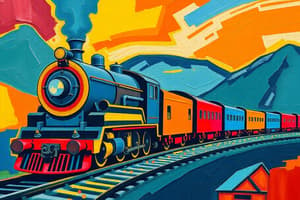Podcast
Questions and Answers
How was the Transcontinental Railroad funded?
How was the Transcontinental Railroad funded?
The railroad was funded by the Big Four Sacramento Merchants, private investors, and the US Government.
Who built the Transcontinental Railroad?
Who built the Transcontinental Railroad?
The Union Pacific officers hired mostly Irish immigrants and freed African American slaves, while the Central Pacific officers hired mostly Chinese immigrants.
Where did the Transcontinental Railroad run?
Where did the Transcontinental Railroad run?
It connected the Atlantic and Pacific coasts.
Why was the Transcontinental Railroad important?
Why was the Transcontinental Railroad important?
Who lived on the Great Plains?
Who lived on the Great Plains?
What were major conflicts with the Native Americans?
What were major conflicts with the Native Americans?
Why were the conflicts with the Native Americans happening?
Why were the conflicts with the Native Americans happening?
What side would I take? (Native American Version)
What side would I take? (Native American Version)
What were the miners on the Great Plains doing there?
What were the miners on the Great Plains doing there?
What was the Oklahoma Land Rush?
What was the Oklahoma Land Rush?
What was the Homestead Act?
What was the Homestead Act?
What were the farmers on the Great Plains doing?
What were the farmers on the Great Plains doing?
What were ranchers on the Great Plains doing?
What were ranchers on the Great Plains doing?
What political party emerged within the farmers?
What political party emerged within the farmers?
Flashcards are hidden until you start studying
Study Notes
Transcontinental Railroad Funding and Construction
- Funded by the Big Four Sacramento Merchants, private investors, and the U.S. Government.
- Government provided land; private industry constructed tracks.
- Built by Union Pacific (hired mostly Irish and African American workers) and Central Pacific (hired primarily Chinese workers).
Route of the Transcontinental Railroad
- Connected Atlantic and Pacific coasts.
- Central Pacific worked east from Sacramento, while Union Pacific started in Omaha, Nebraska, working westward.
Importance of the Transcontinental Railroad
- Had significant economic, cultural, and political impact on the U.S.
- Enabled rapid transportation, facilitating new markets for goods.
Population on the Great Plains
- Mid-1800s settlers included miners, ranchers, and farmers.
- Settlers competed for resources with Native Americans, leading to conflicts.
Major Conflicts with Native Americans
- Sioux uprising in Minnesota, 1862, resulted in violence and forced removals to reservations.
- Colorado Territory tensions arose from miners displacing Native tribes.
- Fetterman Massacre (1866) saw Sioux attacks on U.S. forts along the Bozeman Trail.
- Nez Perce conflict in 1877 led to Chief Joseph's retreat toward Canada.
- Battle of Little Bighorn (1876) involved Custer's last stand against a large Native force.
- Wounded Knee massacre in 1890 marked the end of armed resistance by Native Americans.
Causes of Conflicts with Native Americans
- Disputes over land ownership, cultural differences, and forced relocations to reservations.
Perspective of Native Americans
- Native Americans were the original inhabitants of the land.
- Experienced forcible relocation and violence initiated by settlers.
- Leaders and cultures significantly disrupted.
Mining Activities on the Great Plains
- Miners earned $20 per day exploring states for silver, contributing to significant economic activity.
Oklahoma Land Rush
- Happened in 1889, opened up Unassigned Lands for settlement.
- Covered portions of present-day Oklahoma counties.
Homestead Act
- Enacted in 1862, the Act encouraged settlement on the Great Plains.
- Offered up to 160 acres to heads of families for a $10 fee after five years of residency.
Farmers' Conditions on the Great Plains
- Late 1800s brought economic hardships due to overproduction and declining crop prices.
- Wheat prices dropped significantly from $1.45 in 1866 to 49 cents in the mid-1890s.
- Farmers faced high shipping charges and loan interest, leading to organized support efforts.
Ranchers' Challenges on the Great Plains
- Texas ranchers faced low cattle prices despite high demand in Northern and Eastern markets.
- Cattle sold for $3-$4 in Texas but could fetch $40 in cities.
- Cowhands dealt with dangerous conditions, including storms and cattle stampedes.
Emergence of the Farmers' Political Movement
- Farmers' Alliance evolved into the People's Party (Populist Party) in 1890.
- Advocated for government ownership of railroads and telegraph lines.
- Supported reforms such as limiting presidential terms and direct senatorial elections.
- Had initial electoral success in 1894 but struggled with funding and organization for 1896 presidential race.
Studying That Suits You
Use AI to generate personalized quizzes and flashcards to suit your learning preferences.




